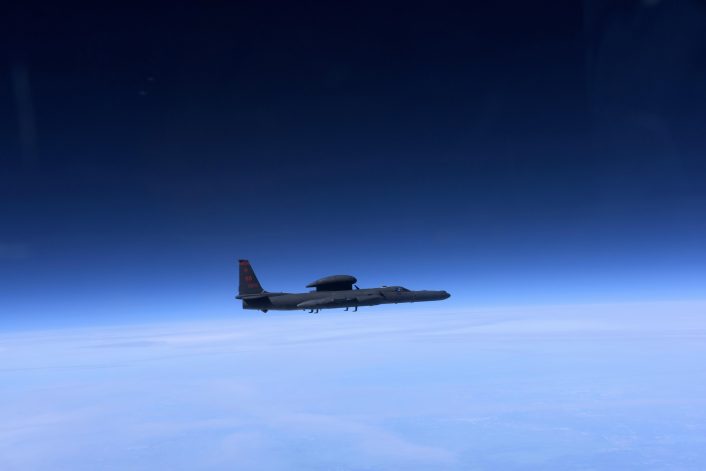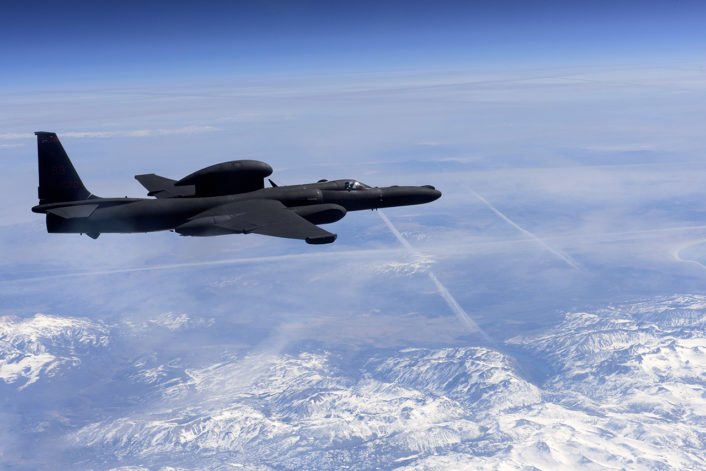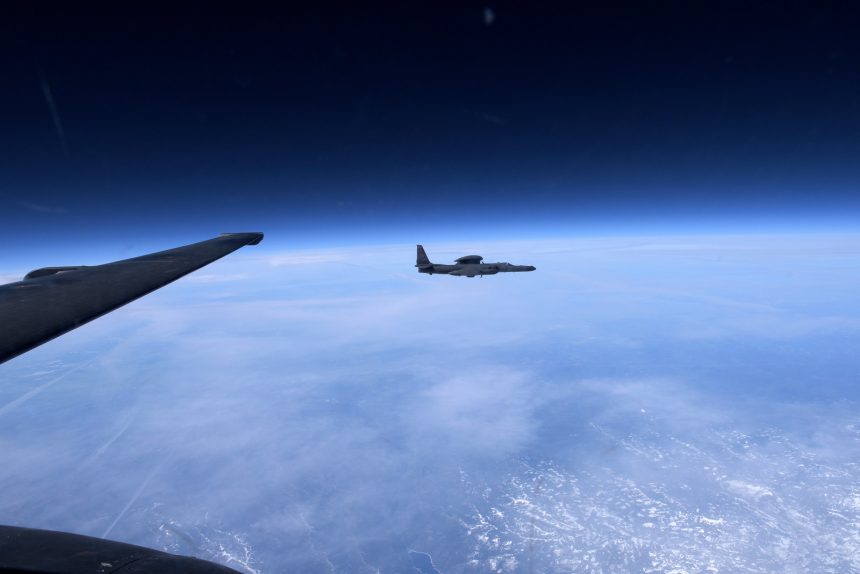The rare formation is also known as “The Double Deuce.”
The majority of the strategic ISR (Intelligence Surveillance Reconnaissance) platforms operate as single-ships: the “recce” aircraft is launched from its homebase (or from a forward operating location) and it is flown by the recon pilot on a pre-planned photo route, “alone and unafraid”. The U-2 Dragon Lady is among them.
Since its first flight back in 1955 and throughout its career, the legendary reconnaissance plane has always operated close (if not over) enemy territory, gathering vital intelligence from an altitude of 70,000 feet where most of enemy interceptors or surface to air missiles could not reach it. Up there, at the “edge of space” (as someone dubbed it), there’s no need to fly in pair as you don’t need the mutual support a wingman provides.
Indeed, images of U-2s flying at very high altitude are quite rare: you can find some shots taken from the cockpit of a lonely Dragon Lady (as the terrific photos we published last year); you can find some images of the spyplane intercepted by a camera ship at lower altitude, but you’ll hardly find pictures taken from a photo ship that show the iconic aircraft at work at FL600+.
A couple of these are the photos that you can find in this article.

The photograph of a U-2 at high altitude taken from another U-2: “Insane”, “awesome” and, above all, “rare”.
With the help of our friend and former Dragon Lady pilot Ross Franquemont, we managed to reach out to one of the aircrews involved in that almost historic aerial photo shooting to learn more about that mission, flown on Mar. 23, 2016.
“I’m a retired Dragon Lady pilot with over 2300 hours flying the U-2; I think that’s probably enough for my background,” told us “Cliffy”, in an email.
“I was the one flying the U-2 that the photo was taken from. The background of this photo mission is that the 9 RW wing leadership wanted some photos of a mission jet that were taken officially (within all the USAF rules, and owned by the USAF) that could be used in official products (websites, PowerPoint presentations, posters, etc). At that point, most of the photos we had were either quite old, or taken on the ground. Most of the airborne ones were “unofficial;” i.e. taken by guys flying the jet, generally without the proper prior permissions. The push to do this was especially keen because at that time we had a jet at Beale that was in a full mission configuration; it had been some time since this had happened, because the sensors and other equipment were often all at overseas locations. This gave us the opportunity to get some pictures of a mission aircraft, at altitude, over the Northern California/Nevada area.”
Indeed, the photo is even more interesting because the pictured aircraft carried the huge Senior Span or Senior Spur dorsal pod, that houses an uplink antenna for satellite communication that allows the U-2S to beam its intelligence (data or imagery) back to any location BLOS (Beyond Line Of Sight) in near to real-time.
So, why was “Cliffy” selected to carry out the photo hop?
“I was selected because I was fairly senior (position and flight time), was a 2-seat instructor, and probably had the most time flying the U-2 in formation of any active-duty pilots at Beale. I flew a 2-seat trainer (TU-2S) with an Air Force Public Affairs photographer in the back seat. The pilot of the single-seat aircraft featured in all the photos was chosen to gain and keep some of what we learned in the U-2 program, as I was approaching retirement. As such, they chose a very sharp, younger pilot that had a lot of formation experience in other aircraft.”
And what about the mission itself?
“As you can tell, this was not an operational sortie. It was planned and executed as a training and photo sortie. We extensively planned it, to include briefing wing leadership and working out contingency plans among ourselves. We took off from Beale, flew low over to the San Francisco bay, took some photos as we flew around the bay (including some of us flying over the Golden Gate Bridge), and then climbed out for the high portion of the flight. We flew over towards Lake Tahoe and did most of the high-flight shots in that general area (Northern California/Nevada). I flew as #2 in the formation so I could position for the photos until we had most of the photos; we then swapped positions so the other pilot could get some time flying as #2. I believe this shot may have been taken as we were swapping positions, with me overtaking the other aircraft and taking over the lead. After flying around a bit to give the other pilot time to experience flying on the wing at altitude, we began our descent back to Beale AFB. We flew back together then split up for separate landings (clearly, you don’t want to try to land 2 U-2s at the same time!).”
The next question for “Cliffy” was “Have you ever flown two-ship operational missions”?
“Although this was not an operational mission, my previous experience with flying U-2 formation had been on operational missions. This had been done for 1 of 2 reasons: Either as a way to gather more intelligence in a shorter time span without requiring additional support from airborne protection, or to further Operational Test and Evaluation that could only be performed on operational missions.”
Whatever the reason for flying two U-2s in formation, the Dragon Lady remains a badass plane and the photos in this post are remarkable!










